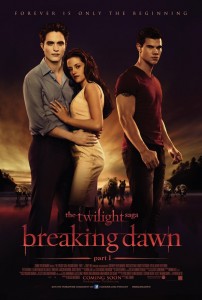 I have never seen a film quite like Hugo. It’s a children’s fable made for adults— and it scares me that most children will probably sit in boredom if their erratic attention spans aren’t captivated by the incredible 3D visuals. Martin Scorsese, of all directors, has facilitated a memorable moviegoing experience for film enthusiasts. Hugo is a movie about movies, about making movies, about honoring movies, and about remembering pioneers of movies. This is all under the guise of a family-film adventure in 3D. If you’re looking for chipwrecking, steer elsewhere.
I have never seen a film quite like Hugo. It’s a children’s fable made for adults— and it scares me that most children will probably sit in boredom if their erratic attention spans aren’t captivated by the incredible 3D visuals. Martin Scorsese, of all directors, has facilitated a memorable moviegoing experience for film enthusiasts. Hugo is a movie about movies, about making movies, about honoring movies, and about remembering pioneers of movies. This is all under the guise of a family-film adventure in 3D. If you’re looking for chipwrecking, steer elsewhere.
Scorsese takes viewers to 1930s Paris, where young boy Hugo Cabret (Asa Butterfield) hides in the tall clock up above the interior of a train station. Hugo lives secluded from the station inspector (Sascha Baron Cohen) sniffing out abandoned children, fully prepared to ship them off to an orphanage.
After the death of both his father (Jude Law) and alcoholic uncle (Ray Winstone), Hugo busies himself keeping the clocks running properly so as to avoid the discovery of his deceased uncle who normally mans the clocks at the station. In his spare time, Hugo scurries about pilfering scrap parts from a toymaker, George (Ben Kingsley), until he is caught one day. George demands Hugo empty his pockets of stolen parts, and in the process steals Hugo’s personal notebook which has diagrams and calculations for building an automaton.
You see, Hugo’s father was an inventor who planned to rebuild a dead automaton he picked up from a museum—this bot having belonged to the legendary filmmaker and magician George Méliès. Hugo eventually teams up with the toymaker’s godchild, Isabelle (Chloe Moretz) to retrieve his sacred notebook which opens up both children to worlds unknown to each other. Isabelle is fascinated with literature and books. Hugo loves gears and machinery. Both end up enraptured by Hugo’s quest to reform the automaton that may hold a message from Hugo’s father as well as secrets about toymaker George.
 In many ways, Hugo is visually one of the most striking films I’ve ever seen. Most of the film takes place inside the Parisian train station where our young hero leaps and bounds through vents and shafts. Scorsese chose to shoot this movie in 3D. A wise move he made. The added dimension is used to grand effect here and compliments the stunning cinematography. I honestly can’t overstate it. Take for example the opening sequence which features a breathtaking single shot that drives viewers down the entire interior of the train station before ending on Hugo’s face behind a giant clock. Scorsese and cinematographer Robert Richardson had me at hello.
In many ways, Hugo is visually one of the most striking films I’ve ever seen. Most of the film takes place inside the Parisian train station where our young hero leaps and bounds through vents and shafts. Scorsese chose to shoot this movie in 3D. A wise move he made. The added dimension is used to grand effect here and compliments the stunning cinematography. I honestly can’t overstate it. Take for example the opening sequence which features a breathtaking single shot that drives viewers down the entire interior of the train station before ending on Hugo’s face behind a giant clock. Scorsese and cinematographer Robert Richardson had me at hello.
Hugo’s mission is clear, even if it isn’t to him. He wants to finish what he started with his father, and in the process, find closure in that relationship. The film deals a lot with human purpose. Hugo comes to the realization that people are like machines, and need fixing once in a while. When a machine isn’t serving its purpose, it isn’t working, just like human beings. He intends to fix the automaton, just as he intends to fix George who sits in his corner booth as a lost and withering old man needing to reclaim his former glory.
To be frank, Hugo is not a movie for everyone. The film delves into the history of filmmaking and eventually becomes a movie for movie enthusiasts. As a family film, many parents may end up scratching their heads while their kids become restless. That really is not a criticism. It’s simply a fair warning. Scorsese has sought to make a personal, passionate, honoring film about the magic of escapism. Some parents and kids, however, may thoroughly enjoy this. There’s no squeaking critters to be found here. No obnoxious zoo animals. Nothing hip in sight. What we do get is a charming, visually stunning, and thoroughly pleasant little movie from a grand storyteller who clearly is giving us a love letter for movies—and it’s in eye-popping 3D.
[Rating:4/5]













